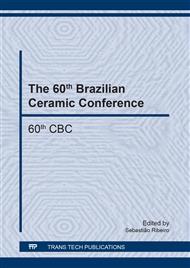p.202
p.207
p.212
p.218
p.224
p.230
p.234
p.240
p.245
Obtainment of Porous Ceramic Structures: A Comparison among Different Compositions and Methods of Conformation
Abstract:
This paper presents comparative results concerning to the obtaining of porous ceramic structures obtained by pressing, slip casting and polymeric sponge method. Three compositions were prepared, using calcium carbonate as pore-generating agent and characterized by X-ray fluorescence, thermogravimetric analysis and determination of sintering behavior. Each formulation was wet mixed and dried. Then, each formulation was formed by each one of the investigated methods. The obtained samples were dried and heat treated with the appropriate heating rate for calcium carbonate degasification and sintered at 900, 1100 and 1180 °C. The sintered samples were characterized by determination of porosity, crystalline phases formed, compressive strength and permeability. Results showed that porosity and permeability depends strongly on the composition and used conformation method.
Info:
Periodical:
Pages:
224-229
Citation:
Online since:
January 2018
Keywords:
Price:
Сopyright:
© 2018 Trans Tech Publications Ltd. All Rights Reserved
Share:
Citation:


